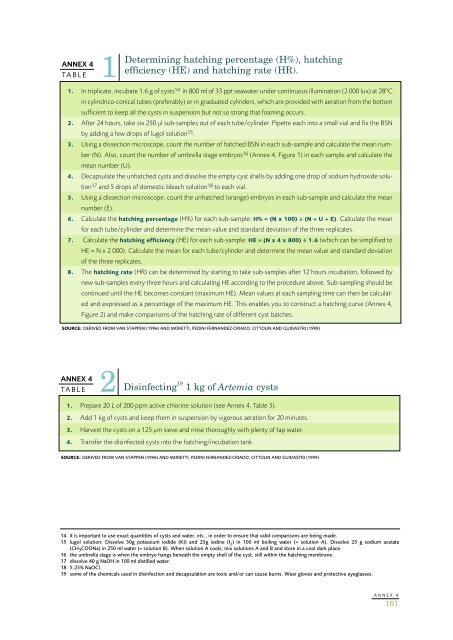Create successful ePaper yourself
Turn your PDF publications into a flip-book with our unique Google optimized e-Paper software.
1ANNEX 4TABLEDetermining hatching percentage (H%), hatchingefficiency (HE) and hatching rate (HR).1. In triplicate, incubate 1.6 g of cysts 14 in 800 ml of 33 ppt seawater under continuous illumination (2 000 lux) at 28°Cin cylindrico-conical tubes (preferably) or in graduated cylinders, which are provided with aeration from the bottomsufficient to keep all the cysts in suspension but not so strong that foaming occurs.2. After 24 hours, take six 250 µl sub-samples out of each tube/cylinder. Pipette each into a small vial and fix the BSNby adding a few drops of lugol solution 15 .3. Using a dissection microscope, count the number of hatched BSN in each sub-sample and calculate the mean number(N). Also, count the number of umbrella stage embryos 16 (Annex 4, Figure 1) in each sample and calculate themean number (U).4. Decapsulate the unhatched cysts and dissolve the empty cyst shells by adding one drop of sodium hydroxide solution17 and 5 drops of domestic bleach solution 18 to each vial.5. Using a dissection microscope, count the unhatched (orange) embryos in each sub-sample and calculate the meannumber (E).6. Calculate the hatching percentage (H%) for each sub-sample: H% = (N x 100) ÷ (N + U + E). Calculate the meanfor each tube/cylinder and determine the mean value and standard deviation of the three replicates.7. Calculate the hatching efficiency (HE) for each sub-sample: HE = (N x 4 x 800) ÷ 1.6 (which can be simplified toHE = N x 2 000). Calculate the mean for each tube/cylinder and determine the mean value and standard deviationof the three replicates.8. The hatching rate (HR) can be determined by starting to take sub-samples after 12 hours incubation, followed bynew sub-samples every three hours and calculating HE according to the procedure above. Sub-sampling should becontinued until the HE becomes constant (maximum HE). Mean values at each sampling time can then be calculatedand expressed as a percentage of the maximum HE. This enables you to construct a hatching curve (Annex 4,Figure 2) and make comparisons of the hatching rate of different cyst batches.SOURCE: DERIVED FROM VAN STAPPEN (1996) AND MORETTI, PEDINI FERNANDEZ-CRIADO, CITTOLIN AND GUIDASTRI (1999)2ANNEX 4TABLEDisinfecting 19 1 kg of Artemia cysts1. Prepare 20 L of 200 ppm active chlorine solution (see Annex 4, Table 3).2. Add 1 kg of cysts and keep them in suspension by vigorous aeration for 20 minutes.3. Harvest the cysts on a 125 µm sieve and rinse thoroughly with plenty of tap water.4. Transfer the disinfected cysts into the hatching/incubation tank.SOURCE: DERIVED FROM VAN STAPPEN (1996) AND MORETTI, PEDINI FERNANDEZ-CRIADO, CITTOLIN AND GUIDASTRI (1999)14 it is important to use exact quantities of cysts and water, etc., in order to ensure that valid comparisons are being made.15 lugol solution: Dissolve 50g potassium iodide (KI) and 25g iodine (I 2 ) in 100 ml boiling water (= solution A). Dissolve 25 g sodium acetate(CH 3 COONa) in 250 ml water (= solution B). When solution A cools, mix solutions A and B and store in a cool dark place.16 the umbrella stage is when the embryo hangs beneath the empty shell of the cyst, still within the hatching membrane.17 dissolve 40 g NaOH in 100 ml distilled water.18 5.25% NaOCl.19 some of the chemicals used in disinfection and decapsulation are toxic and/or can cause burns. Wear gloves and protective eyeglasses.ANNEX 4161
















